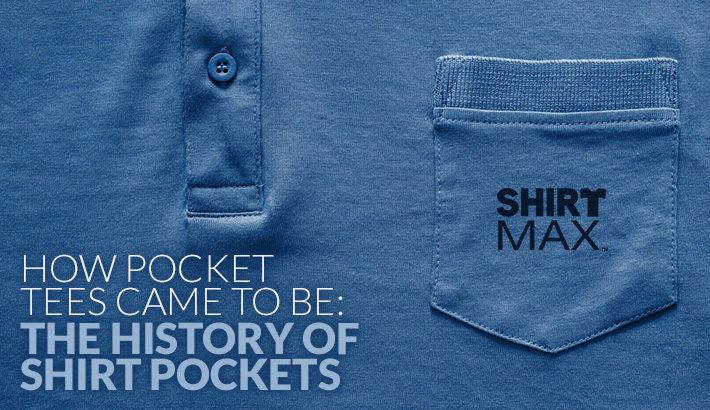The humble t shirt is one of the most popular garments in the world. You would be hard-pressed to find an American closet that doesn’t contain at least a few t shirts. From basic solid colors to those emblazoned with logos, graphics, and other designs, t shirts are a wardrobe staple. Even if you don’t wear yours every day, you likely have a few of them hanging around.
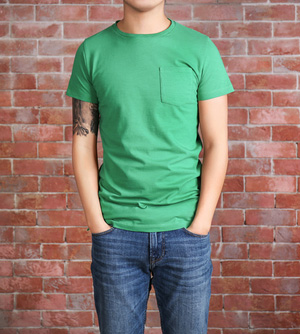 Compared to other types of clothing, though, the t shirt is a relatively new addition to our collective wardrobe. While it has existed in some form since the late 1800s, today’s most popular outerwear choice was once reserved to be worn solely as underwear.
Compared to other types of clothing, though, the t shirt is a relatively new addition to our collective wardrobe. While it has existed in some form since the late 1800s, today’s most popular outerwear choice was once reserved to be worn solely as underwear.
The modern-day t shirt evolved from body coverings that were commonly worn as undergarments in the 19th century. While still often worn as an undergarment—especially under dress shirts—the t shirt came into its own in the middle of the 20th Century. The addition of a pocket further propelled the humble t shirt to wardrobe-must-have status.
Let’s take a closer look at the evolution of the tee shirt pocket and how shirt pockets came to be.
The Early Days of T Shirts
In 1868, a type of all-in-one clothing piece known as the union suit was patented in New York. The union suit worked extremely well for keeping workers warm during the winter months, but it was useless during warmer weather. The first t shirt came to be when someone decided to simply split the union suit into two separate pieces. The top half was left long enough to be tucked into the waistband of the bottoms.
Undergarment manufacturers began working with various fabrics and styles to create cooler, more comfortable undershirts. By the late 19th century, both undershirts with buttons and those without buttons—which more closely resembled the modern-day tee—hit the market. They were made from wool or cotton and featured stretchy necks that you could pull over your head without ruining the collar.
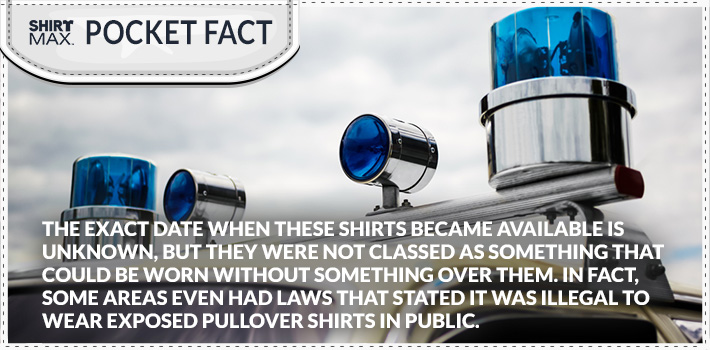
The exact date when these shirts became available is unknown, but they were not classed as something that could be worn without something over them. In fact, some areas even had laws that stated it was illegal to wear exposed pullover shirts in public.
In 1904, the Cooper Underwear Company began marketing pullover undershirts to young men as “bachelor undershirts.” The products tagline read simply: “No safety pins—no buttons—no needle—no thread.” This advertisement showcased that these undershirts were made of a single piece of fabric without buttons and would be more durable with less maintenance.
Between the Spanish-American War in 1898 and 1913, the U.S. Navy began issuing pullover t shirts without buttons as undergarments for enlistees. They were ideal for young soldiers who had minimal sewing skills and would struggle to replace buttons on button-down shirts.
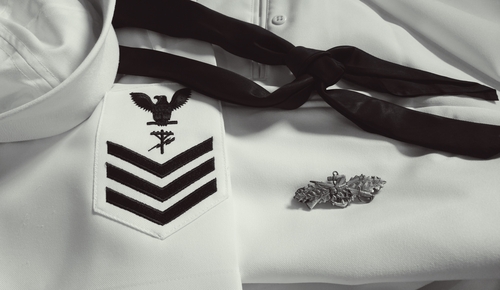
These so-called bachelor shirts were short-sleeved, made of white cotton, and featured crew necks, and they were intended to be worn under uniforms. In time, it became common for sailors and Marines working in hot climates and in work parties to remove their uniform jackets and wear only the undershirt.
Soon after the conclusion of World War I, the Army adopted the plain white tee as part of the standard issue ensemble for new recruits. As a result, tens of thousands of t shirts found their way into American closets and dressers and quickly were incorporated into both casual and professional outfits.
Manufacturers recognized the benefits and versatility of t shirts and began producing them in children’s sizes, in addition to adult sizes. Early t shirts were easily cleaned, easily fitted, and affordable, and they quickly became popular as undershirts for workers in various industries. They also became the shirt of choice for many young boys for the same reasons. While most tees for adults were white, various colors and patterns were available for children.
By the 1920s, the word “t shirt” became common in American dialogue. Shortly after the end of World War I, author F. Scott Fitzgerald used the word “t shirt” in print for the first time in the novel, This Side of Paradise. At this time, it made its way into the Merriam-Webster dictionary.
By the time of the Great Depression, the t shirt became the primary garment for workers on farms and ranches. They were also commonly worn by employees in other industries where modesty was required but hot conditions required a lightweight fabric. Worn by Navy men as undergarments during World War II, they were also worn by veterans after the war as casual clothing.
The T Shirt’s Rise to Fame
The humble t shirt reached celebrity status in the 1950s when one was worn by Marlon Brando in A Streetcar Named Desire. In the movie, Brando wears a fitted t shirt that shows off his biceps. It was this movie that fully propelled the t shirt to the status of a fashionable, stand-alone garment. Sales of the simple t shirt spiked following the release of A Streetcar Named Desire, and, despite the more than 60 years that have passed since then, it remains a popular fashion staple.

The t shirt’s rise to fame didn’t stop with Brando, though. In 1955, James Dean wore a plain white t shirt with a pocket in Rebel Without a Cause. Don Johnson renewed the love for this simple top in the mid-1980s when he wore one under his Armani suit in Miami Vice.
Since then, celebrities from all entertainment industries have worn t shirts in movies, on television, and on stage. From Madonna in the 1990s to Kendall Jenner in 2014, just about every type of celebrity you can imagine has donned a t shirt in the public eye at least once.
The Addition of the Pocket
Pockets have been incorporated in clothing for more than 500 years, but adding them to the t shirt happened much more recently. Chest pockets on t shirts became common in the 1950s and 1960s as a result of the decline of the waistcoat and because more and more people were wearing t shirts as outerwear. The chest pocket provided a convenient location to store cigarettes, pens, and other small items.
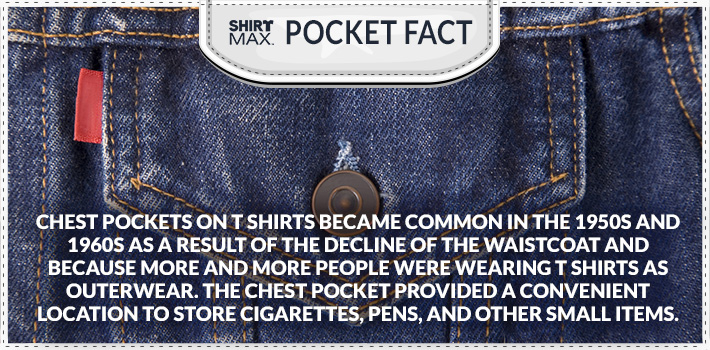
Modern pocket t shirts typically have rounded or square pockets. The pocket is usually positioned on the left side of the chest, but there are shirts that feature the pocket on the right as well. While pocket t shirts are available for both men and women, men’s styles are the most popular and tend to have pockets that are more functionally sized than those found on women’s t shirts.
A Brief History of Pockets
While little is known about exactly when a pocket was added to a t shirt for the first time, there is a long, well-documented history of pockets. The word “pocket” is derived from the French word “poque,” which translates to “bag”. Up until the 19th century, pockets were quite different from the sewn-in pockets we have today. Instead, they were small bags or pouches inserted in or attached to garments.
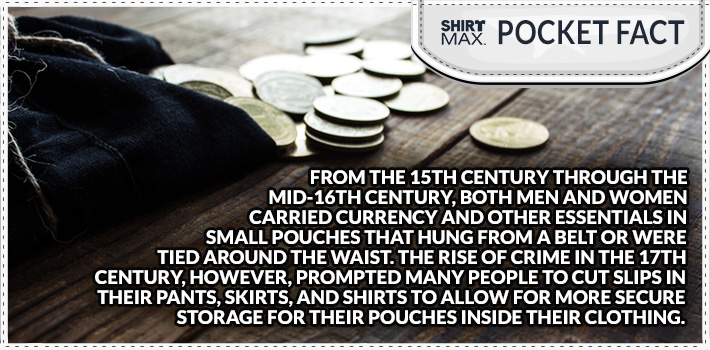
From the 15th century through the mid-16th century, both men and women carried currency and other essentials in small pouches that hung from a belt or were tied around the waist. The rise of crime in the 17th century, however, prompted many people to cut slips in their pants, skirts, and shirts to allow for more secure storage for their pouches inside their clothing. In order to successfully tuck pouches inside clothing, it became necessary for the bags to be made flatter and more easily accessible – more like a modern pocket.
 As men’s clothing became more form-fitting, it became more difficult to tuck a pouch between the body and clothes. As a result, tailors began sewing pocket bags into the seams of men’s pants and coats. By the 1900s, men’s garments came with a wide variety of pocket types, including watch pockets, inside and outside breast pockets, side/hip pants pockets, ticket pockets, etc.
As men’s clothing became more form-fitting, it became more difficult to tuck a pouch between the body and clothes. As a result, tailors began sewing pocket bags into the seams of men’s pants and coats. By the 1900s, men’s garments came with a wide variety of pocket types, including watch pockets, inside and outside breast pockets, side/hip pants pockets, ticket pockets, etc.
Women’s pockets, however, remained largely unchanged through the late 1800s. Since women wore billowing dresses, they carried pouches which were accessed through placket holes in the back of skirts. Unfortunately, this design made women an easy target for pickpockets. In response, many women began carrying small drawstring bags in their hand instead. While sewn-in pockets did find their way into some women’s clothing, the more fitted fashions of the 20th century made spacious pockets impractical. This led to the rise in popularity of purses and handbags and remains the primary reason why modern women typically carry purses while men use pockets.
Cargo Pockets
Cargo pockets are the utilitarian of the garment world. In the early 20th century, the pocket made its way to men’s pants and expanded in size to become the popular cargo pocket. First introduced by the British in 1938, cargo pockets have proven extremely useful for members of the Armed Forces. During World War II, the military used a wide variety of cargo pocket designs. Some soldiers carried so much gear in their pockets that they had to wear suspenders just to keep their pants up.
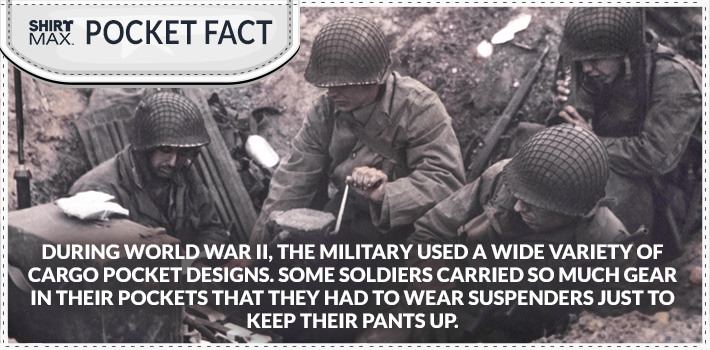
Today, the cargo pocket has become a staple in men’s fashion. Found on both shorts and pants, they work well for both casual and work wear. Cargo pants are especially popular among hikers, carpenters and others who carry a substantial amount of gear. Of course, they’re also a popular design from a fashion standpoint, and many people wear them simply because they like how they look.
In Conclusion
Shirts, pockets, and shirts with pockets have come a long way. As humans, we’ve always had a need to carry currency and other essentials with us, and pockets allow us to do that. As our needs and fashion trends have changed, so has our clothing. Pocket t shirts combine the comfort and style of a classic t shirt with the convenience of a pocketed shirt, and they are a wardrobe staple. Given the humble pocket’s rich history, there is no doubt that they will remain a vital garment component for centuries to come.
